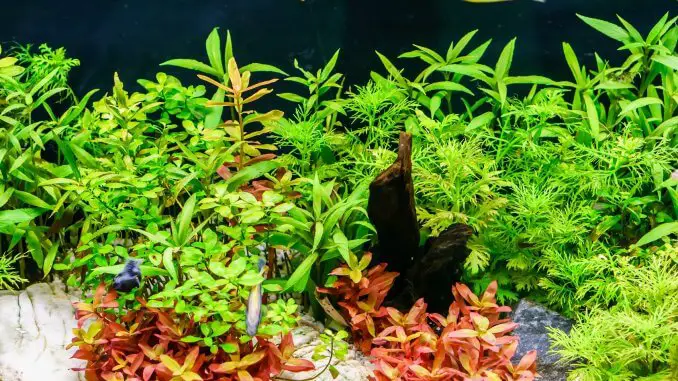
Planted aquariums are becoming increasingly popular, especially within the aquaculture scene.
Not only do plants add color to your aquarium, but they also play vital roles within the tank’s ecosystem.
They provide an important method of filtration by removing excess nutrients and harmful elements and chemicals. They also act as shelter for adult fish and their fry as well as shade which helps to prevent algae growth.
In this article, we will explain the best aquarium plants for different aquariums and how they can be cared for correctly and propagated within the aquariums of beginners and experts alike.
Aquarium Plants for Beginners
Plants come in lots of different varieties and species, with some being difficult to care for and others that are easy to keep. In this section, we will talk about a couple of species that are on the easy end of the scale.
These plants are perfect for beginners who are just starting to learn how to keep aquarium plants.
1. Amazon Sword
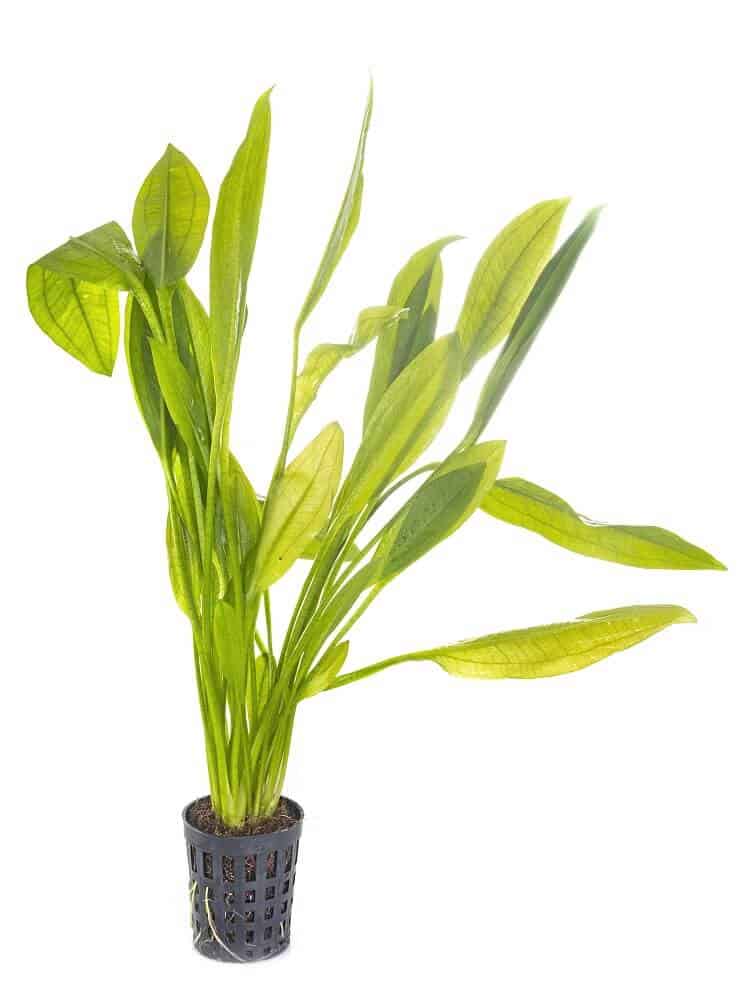
As its name suggests, the Amazon Sword plant is a species that is native to the Amazon Basin of South America. They will thrive in water conditions with temperatures of 60.8-82.4°F and a pH of 6.5-7.5.
The Amazon Sword plant looks like a bush and has long leaves which resemble swords or spearheads – these leaves extend straight from the roots.
Roots should be planted in a substrate like gravel, which will provide plenty of space for the roots to grow.
Mixing in aquarium soil beneath the substrate will provide essential nutrients for the plant, although these nutrients can also be provided by adding liquid fertilizer to the water.
These plants develop their own plantlets which will eventually grow their own root system and leaves. When this does happen, the plant can be cut from the parent and placed elsewhere within the aquarium.
2. Duckweed
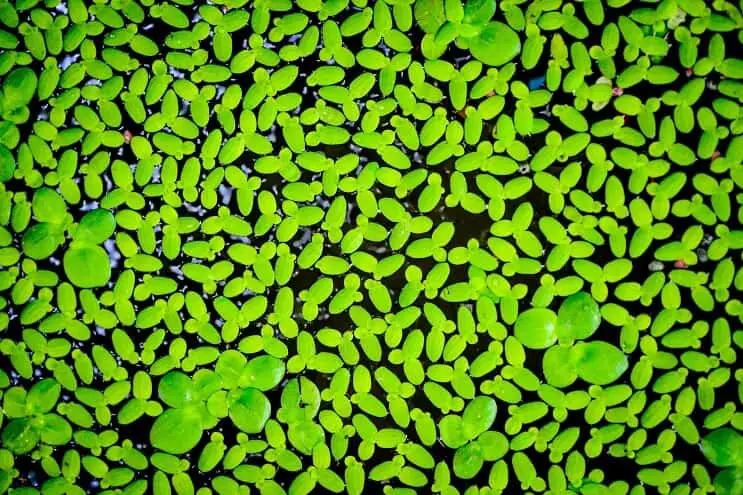
Duckweed is a small species of floating plant.
These plants are often found in large masses in lakes ponds and rivers and each plant can grow to around 1.5 inches in length.
They are some of the easiest plants to keep in aquariums as the only things they require are nutrients within the water as well as light.
When they have both of these they can quickly multiply through a process called vegetative reproduction.
They grow best in water with a pH of 6.5-7.5 and different species can tolerate a wide range of temperatures including tropical and arctic conditions.
These plants can aid in water filtration by absorbing excess nutrients and harmful elements. The roots of the plants can also provide a safe hiding place for juvenile fry, such as guppies.
A major benefit of keeping Duckweed is that it forms a shaded area that blocks light to the tank which aids in controlling unwanted algae growth. However, do not let it grow too thick as some light is beneficial for underwater plants.
Floating Aquarium Plants
Unlike most aquatic plants, floating plants do not anchor their roots into the substrate.
Instead, the roots are free hanging and absorb nutrients from the water. Floating plants are a great addition to any freshwater aquarium and in this section, we will discuss the two best floating plants for your tank.
3. Hornwort
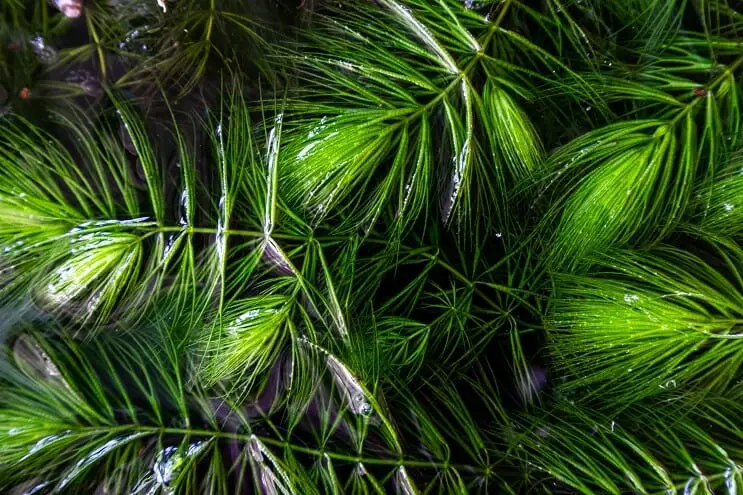
Hornwort can not only be a floating plant but can also be anchored to the substrate. It depends on the type of look you want within your aquarium.
Adding it to the tank as a floating plant will not only provide shelter for your fish, but will also provide shade and effectively combat unwanted algae growth.
Hornwort has a long green stem with branches that lead into thin but darker colored leaves.
It is easily propagated through asexual reproduction via side shoots providing it gets enough light and nutrients. You should aim to keep it within an aquarium with a stable pH of 6.0-7.5 and a temperature of 59-86°F.
Due to its ability to tolerate a wide range of water conditions, it has spread overtime to areas where it is not native, making it an invasive species.
4. Water Lettuce
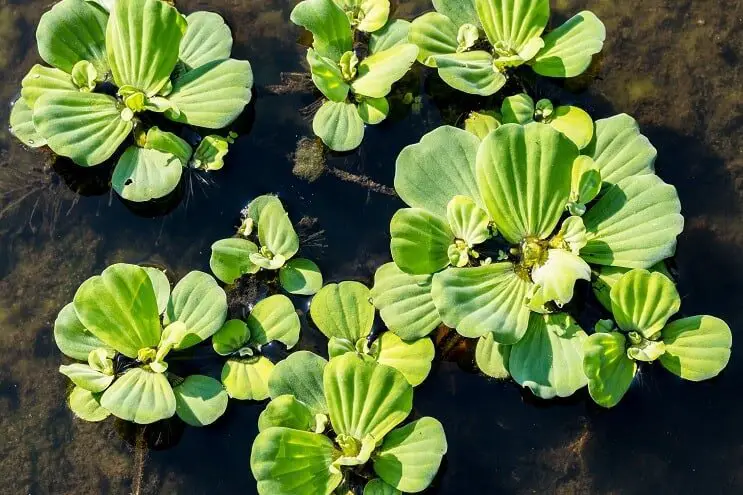
The Water Lettuce, also known as the Water Cabbage, is a green floating plant that looks like Lettuce. It has thick but soft leaves which give it the look of an opening Lettuce or Cabbage, and even has small flowers hidden within its center.
It is found in the tropical freshwaters of South America, Africa, and Southeast Asia. They are considered an invasive species due to the fact they can populate almost all tropical freshwater.
Water Lettuce is a dioecious plant, meaning that it can produce either sperm or eggs but never both. Sexual reproduction is not the only method used by this plant – it can also reproduce asexually with mothers and daughters being connected by runners.
They are very easy to care for, you just need to make sure they have a good amount of light and access to nutrients (you can add fertilizers to the water every now and then).
Low Light Aquarium Plants
Most plants require a lot of light to be able to photosynthesize in order to produce energy for growth.
However, there are some species that are able to grow in low light. In this section, we will discuss the perfect low light plants we believe to be ideal additions for beginners and experts alike.
5. Anubias
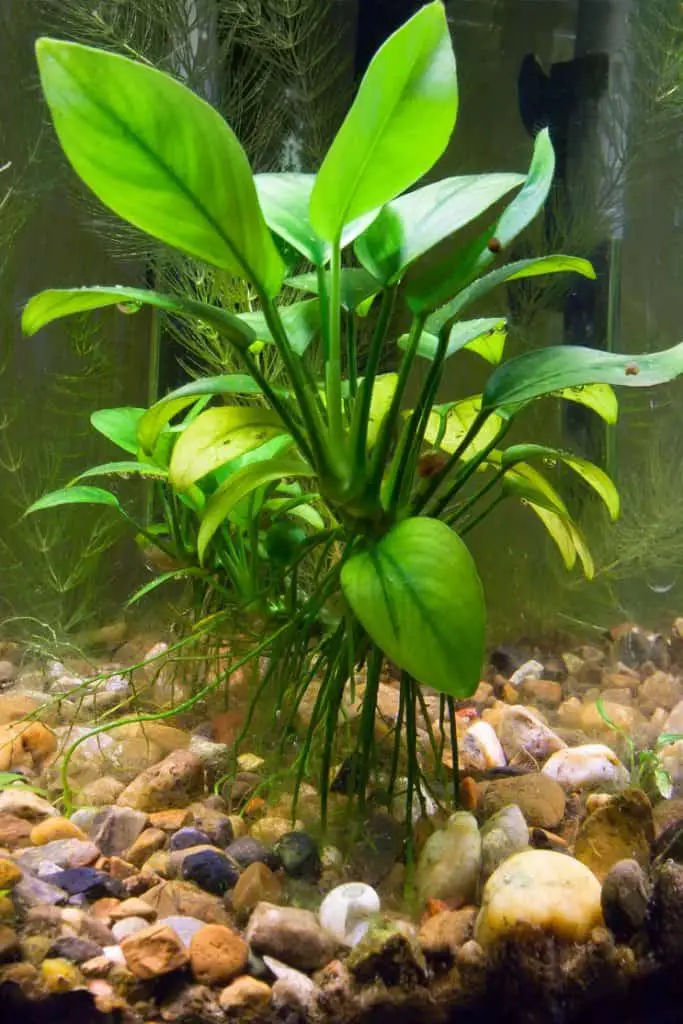
Anubias are root feeders and should be planted in the bottom of the tank within a substrate like gravel. They are native to rivers, streams, and marshes of Central and Western Africa.
Anubias Nana is one species of Anubias that does well in low light conditions. They are very hardy and can survive in a wide range of water conditions. They should be kept in water with a pH of 6.0-7.5 and a temperature of 72-82°F.
This plant has thick green stems which can be planted in the substrate or attached to driftwood. These green stems contain multiple branches which grow upwards leading in thin green leaves which are covered in a waxy coating.
They are extremely easy to propagate as they do so via rhizome division. This is where a part of the plant’s stem will break off and fall to the substrate where it will start to develop its own shoots and roots. Cuttings of the stem may be taken but be sure it has plenty of leaves attached so that it can still photosynthesize.
6. Java Fern

Java Fern is a hardy species that can tolerate a wide range of parameters and conditions.
It does best when planted in a gravel substrate or attached to rocks as it absorbs nutrients through its root. It should be kept in tropical aquariums with a temperature range of 62-82°F and at a pH of 6.0-7.5.
They also require low to moderate lighting, which makes them some of the easiest plants to care for.
The plant is made up of two parts: the rhizome and the leaves. They can be propagated in two ways:
- The first way is through rhizome division where cuttings can be taken from the plant and moved elsewhere within the aquarium.
- The second propagation technique is that the plant will actually produce its own small ferns on the underside of its leaves. If you wait for them to develop their own leaves, these can also be cut from the parent and planted in a different location.
7. Vallisneria
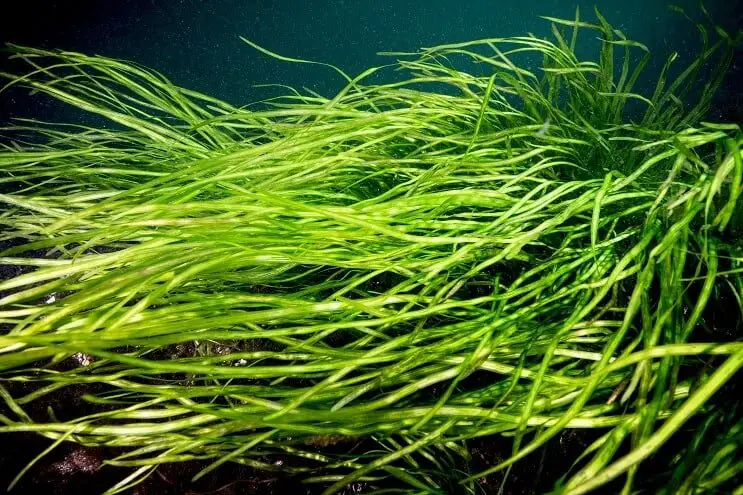
Vallisneria is also known as Eelgrass because it has long ribbon-like leaves. The roots should be planted in a nutrient rich substrate that is also well aerated allowing the roots to spread. It is a hardy and fast-growing species which makes it great for beginners.
They prefer temperatures of 68-82°F and a pH of 6.5-8.5. They can grow in both low and moderate lighting.
Interestingly this plant produces both males and females which are both flowers – although this isn’t seen as regularly in aquariums.
The females have flowers at the surface of the water whereas the males flower below the water.
These eventually break from the plant and float to the surface where they will encounter female flowers which they will pollinate.
Red Aquarium Plants
The vast majority of aquarium plants are green. This is because the primary pigmentation present in these plants is Chlorophyll which is green in color and is vital for photosynthesis.
However there are a few red plants. They still have Chlorophyll (as it is needed for photosynthesis) however the main pigments within them are Anthocyanins.
8. Ludwigia Repens
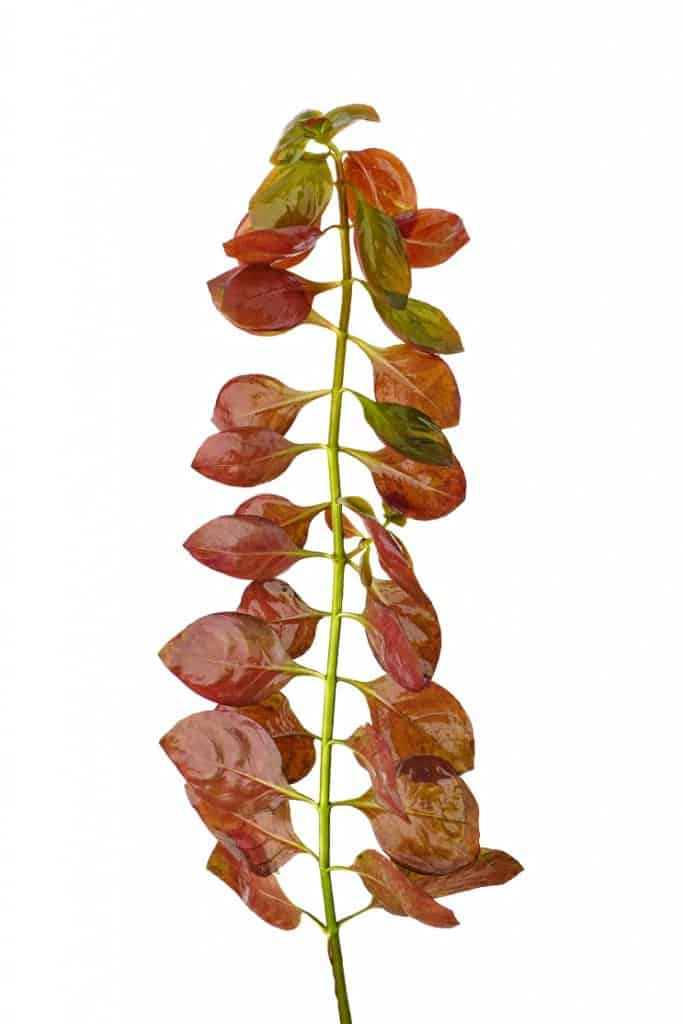
Ludwigia Repens is a species of plant which is thought to have originated in South America.
It is an extremely popular plant, especially in Dutch aquascaped aquariums for which the presence of different colors is needed.
They have a single stem with a root system that should be planted in a substrate with large particle size. Along the stem and its leaves, the coloration can vary from deep green to dark red.
It grows best when kept at a temperature of 59-86°F in water with a pH of 5-8. As you can see, these plants can tolerate a wide range of conditions making them extremely hardy.
The propagation of this species is relatively simple and will occur when the plants are mature and during the warmer months when they will grow surface flowers that produce seeds. These seeds will eventually sink down to the aquarium substrate where they will grow into new plants.
9. Echinodorus
The Red Diamond Echinodorus is a variety of Amazon Sword plant which is likely a crossbreed between E. hartmanni and E.barthii which has resulted in a plant with deep red sword-like leaves.
It should be treated exactly the same as the Amazon Sword plant discussed earlier in the article and be kept in water conditions with temperatures of 61-82°F and a pH of 6.5-7.5.
Planting the roots in aquarium soil beneath a gravel substrate will provide nutrients for the plant, although these may also be absorbed by adding liquid fertilizer to the water.
These plants develop their own young which will eventually grow their own root system and leaves. When this happens the plant can be cut from the parent and placed elsewhere within the aquarium.
Aquarium Carpet Plants
In this section we will provide you with the three best carpet plants for both beginners and experienced aquarists.
10. Java Moss

Java Moss is native to Southeast Asia and can tolerate a wide variety of water conditions. These range from low to high lighting in waters of pH 5.0-8.0 and at a temperature of 59-86°F. They are an extremely hardy species making them ideal for any freshwater aquarium.
This plant is a moss with small branched stems. Each stem has small overlapping oval leaves and these leaves are bright green in color.
When planting this species, it can be tied down to a rock to keep it from rising to the surface. Eventually, it will attach itself to a rocky substrate using rhizoids to keep it in place.
Propagating Java Moss is as simple as it gets. Cut a piece off of the main clump and it will start growing and can be placed elsewhere in the tank or even in another tank to begin carpeting that one.
11. Water Wisteria
Water Wisteria is a species of freshwater plant native to the Indian subcontinent. Stems can reach up to 20 inches in length and have a width of around 10 inches.
The stems are slightly darker than the bright green leaves which occupy them. These leaves are oddly shaped with narrow protrusions along with.
It can be planted into the substrate of the aquarium or allowed to grow across the substrate to form a carpet.
This species requires moderate to high lighting as well as water temperatures of 70-82°F. The pH of the water should be maintained between 6.5 and 7.5.
12. Pygmy Chain Sword
This species is the smallest species of sword plants and is native to the Central and Northern parts of South America.
It will grow to around 4 inches long and about 1 inch wide. The stems and leaves are thin and grow upright but slightly curved. The leaves are green to slightly red in color. It should be planted into a large particle sandy/gravel substrate.
Over time the plant will begin to produce its own runners and form a thick carpet across the aquarium. Once these runners have produced their own leaves, they can be cut from the parent plant and planted in separate aquariums.
They grow best in high light conditions with around 10-12 hours per day. The water should be 68-84°F in temperature and have a pH of 6.2-7.5 for optimal growth rates.
Summary
Plants come in all different shapes, colors, and sizes and can occupy different areas of the aquarium. They provide essential filtration to the tank as well as providing shelter and shade for the aquarium’s inhabitants.
Planted aquariums are becoming increasingly popular as they provide the ideal natural environment for fish and shrimp.
The list of plants we have covered here is all extremely hardy, relatively fast-growing, and able to tolerate a wide variety of different parameters – making them easy to care for.
We hope that we have captured your interest in freshwater plants for your tank and that you enjoy the fun that comes with arranging your aquarium with floating, carpeting, and water column plants.
Which is your favorite aquarium plant? Let us know in the comments section below…

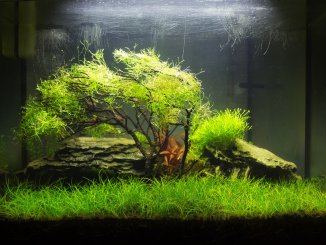
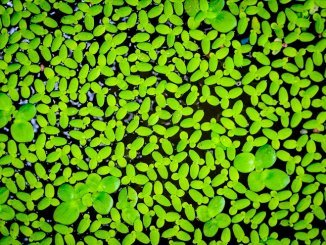
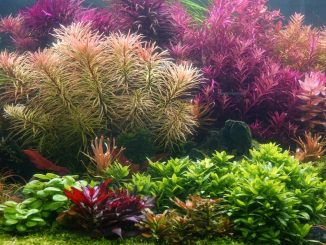
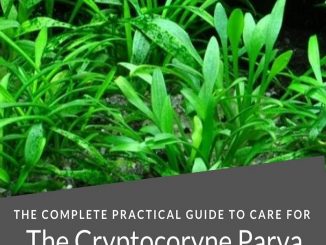
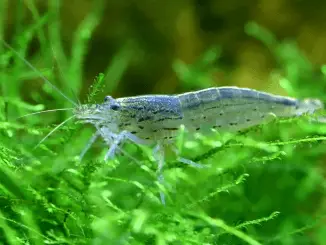
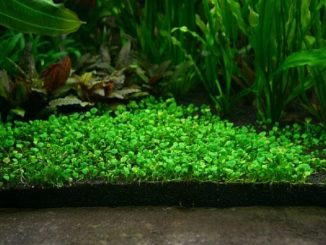
Anubias should not be planted in the substrate like your article says.
Hi Gregory, as long as the rhizome is left above the substrate this plant will grow just fine in the substrate. Thanks, Robert
Very informative! Thank you for this. I am saving all of your articles, like a little library on my computer and iPad, for when I need to know something or need a refresh, which is is always.